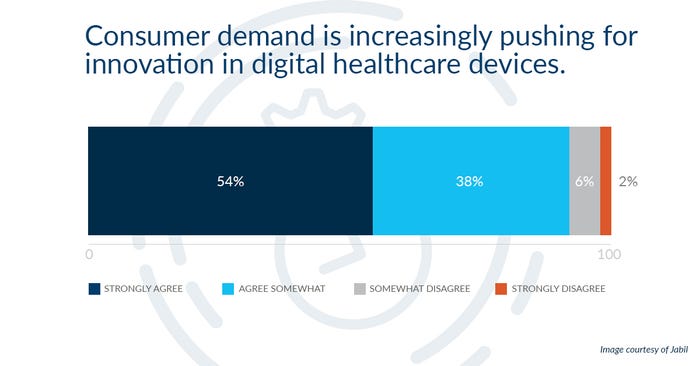Digital health offers tremendous benefits within the medtech industry’s reach. To explore what work remains, here are five takeaways from Jabil’s 2020 Digital Health Technology Trends Survey.

In a matter of months, the coronavirus, SARS-CoV-2, has impacted business and economic sectors across the globe. For healthcare businesses, the COVID-19 pandemic is stress testing every assumption, system, and solution in the industry. Both disruptive and transformative, the crisis is fast-tracking healthcare trends that have been primed and ready for more extensive roll-out for the last few years. Remote digital health solutions are suddenly all the news.
Remote-care solutions like telehealth and wearable devices are included in the new approach that healthcare professionals will be embracing as they position their businesses to best serve patients in a COVID-19 world. Digital healthcare product solutions address critical issues for the remote delivery of care or the “hospital at home” that have been resonating long before we began looking at all our interactions through a social-distancing lens.
People are living longer; chronic health issues diminish too many people’s quality of life; adequately trained healthcare workers are in limited supply, stressing physician workloads; escalating costs are squeezing patients, payers, and providers alike. The market is rewarding those who can deliver healthy outcomes—a potent force driving the ramp up in adoption of digital health’s innovative technologies.
To gain insight on where we are on this ramp, Jabil Healthcare recently partnered with Dimensional Research to survey more than 420 healthcare professionals with decision-making responsibility at companies with existing or planned digital healthcare products. Here are five of the biggest takeaways from the 2020 Digital Health Technology Trends survey:
1. The Primary Healthcare Innovation Driver is Consumer Demand
As anyone working in consumer-facing businesses will tell you: the need for innovation is constant. In healthcare, patients as well as providers are the consumers—and as such, are the primary drivers of innovation. Wants and needs for better, faster, more-intuitive, and more-efficient healthcare products are giving fuel to the same kinds of technology upgrades that have been ongoing for years in consumer businesses like mobile phones. Even other heavily regulated industries like automotive have managed to achieve shorter product development cycles and add digital features to their products. There’s no other way to keep up with the accelerated pace of technology.
In Jabil’s survey, 92% of respondents agreed that consumer demand is pushing innovation in digital healthcare devices. For so long, healthcare device manufacturers have been driven primarily by advancements in therapy with the goal of achieving healthy outcomes within the restraints of a highly regulated industry. As they shift their focus to become more responsive to consumer demand, they will also need to determine how to delight their users through new experiences while still facilitating healthy outcomes.

In today's market, it is an absolute necessity that products get to market quickly and that innovations are in sync with customer wants and needs. Market delays, unintended obsolescence, or even under-actualized utility will undermine product value and provide a wide-open gateway for more nimble competitors.
2. Wearables and On-Body Devices are the Trendiest Solutions
Real-time data collection and communication are critical to digital health initiatives. More than half of survey respondents—52%—said they are currently developing or planning to develop wearable or on-body devices as part of their strategy. Another 33% said the same for patient-monitoring solutions.
As familiar devices like fitness trackers and heart monitors are increasingly paired with Internet of Medical Things (IoMT) platforms, healthcare wearables will be playing the lead role in the future of digital health. Miniaturization, flexible circuitry, and biometric capturing sensors are leading to exciting new devices that will help patients in recovery or with chronic issues. The data communicated from these solutions will equip healthcare providers and patients with the data that can transform healthcare.
Today, we are witnessing the robust build out of mature digital health platforms to aid in both predictive and preventative medicine. Care is being shifted outside the hospital. Smarter devices—for patient monitoring, for analysis, for communication—will disproportionately improve patient outcomes compared with existing treatment and care models. This approach is all about reducing costs while still improving quality of care.
3. Digital Health Solutions See Shorter Development Timelines
In Jabil’s 2018 survey, survey participants unanimously agreed that digital health was lagging behind other industries. One of the main indicators of this performance was in the product lifecycle.
Historically, the product development and launch cycles for a conservatively managed healthcare company has averaged eight years—or even longer. Things are different now. The renewed focus on digital solutions has led to the hyper-fast evolution of healthcare technology that is tied with the therapies.
This is a true crossroads for many long-standing, stable healthcare franchises: adapt to the accelerating pace of change or become a footnote. Product cycles are ground zero for rethinking the status quo.
Today, two-thirds of participants say their product development and launch cycle for digital healthcare solutions is less than two years. The percentage of those with product cycles of less than 18 months is at 41%, up from 29% in 2018.
The market indicates that healthcare solution providers need to iterate every two to three years or risk losing market share.
4. Interoperability is Critical for Digital Health Success
Seamless technology integration is key to delivering the type of predictive and preventative experiences described in every forecast of digital health. Our journey relies on a range of emerging technologies, including artificial intelligence (AI), 5G, cloud-based applications, and a growing roster of IoMT devices.
Medical devices that serve within digital health platforms require cross-industry collaboration and input to further progress. Bringing a digital healthcare platform to market requires more than the expertise of a single solution provider; it must permit different service providers to combine their expertise.
Most importantly, these devices and platforms need to be designed for interoperability. Gaps or misalignment within systems, such as data platform for sharing EMRs (electronic medical records) or communicating biometric data, adds disruptive complexity and cost to an already overburdened healthcare system. Without it, the future potential of digital health cannot be unlocked. And this is really the key—the more alignment, the more data, the better the overall system…for everyone. Scale is so important, and limitations just mute the tremendous benefits that, even now, are within reach. The industry has all the tools at its disposal—it just needs to make it work.
More than nine in 10 healthcare solution providers agree that the collection and purposing of data should be standardized to enable interoperability between devices and within product platforms, according to the survey.
What’s surprising, however, is the misalignment of these views to the approach solution providers are pursuing today over the elements of the ecosystem over which they have direct control. Nearly half (46%) of participants say they prefer to deliver all needed functionality within their own controlled ecosystem so they have complete control over the customer experience; 41% say they prefer to follow generally accepted industry standards that enable interoperability within the ecosystem that adopts those. While the latter may open the industry up to stronger collaboration, there is no indication that the former is looking to change their approach. Meanwhile, 13% say they prefer to be open and enable their consumers to do anything they want, following an open-source approach.
5. External Partners Help Make Digital Health a Reality
As we discussed earlier, bringing digital health platforms to life requires collaboration, both within your industry and outside of it. In fact, enlisting outside expertise can be one of the most efficient ways to solve challenges within your solution ecosystem. You, as a medical device or healthcare solution provider have the domain expertise in your field. Partners can help amplify your power by bringing in additional expertise to make your solutions a success or at least remove some of the obstacles on the way.
Almost all participants (97%) identified a challenge for which their company requires outside expertise and partnership. Among these challenges, nearly half (50%) said they needed support in regulations, certifications, and approvals; 42% said they needed external expertise in data capturing, security, and analytics. Another 42% said they needed healthcare supply-chain management expertise, which will become increasingly important as digital health solutions find their footing.
The concept here is more about opening up and reaching out to collaborators whose insights and experience will truly help unleash the power of agility into your product management strategy. The best partnerships capture intelligence, assist in product roadmap development, understand domain and regulatory requirements from different industries, and enable you to move at the speed that technology changes.
When evaluating potential or current partners, ask your team:
Does this partner have the experience, scale, and commitment to get us fully connected?
How will this partner empower our position in an evolving healthcare ecosystem that’s becoming more platform- than product-focused?
The Only Way in Digital Health is Forward
Our survey was conducted before the current healthcare crisis and shows an undeniable trend toward greater investment and focus on digital health solutions. At this unique inflection point for healthcare, the challenges are daunting, but certainly not insurmountable. In fact, the opportunity presented by today’s market is exceptional. The COVID-19 pandemic has revealed the usefulness and validity of new technology-enabled care protocols, like telehealth and remote patient monitoring. Its increased use during this crisis will speed the already growing acceptance and adoption of digital solutions for both healthcare professionals and their patients. It’s time to consider the top five trends outlined in this report—along with the full survey result—and evaluate where your company stands and where it’s going.
About the Author(s)
You May Also Like


